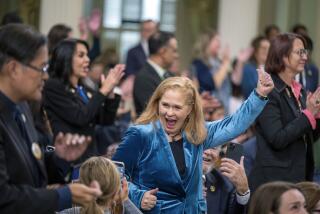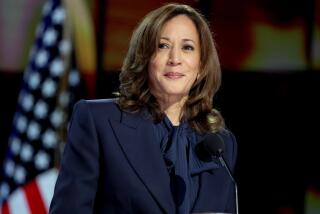Analysis: For Democrats in California, a generational shift pulls the party left, with danger and opportunity ahead
Reporting from Sacramento — For decades, Democratic politics in the nation’s most populous state has been overseen by a quintet of leaders who helped propel California from reliably Republican to dominantly Democratic.
To outsiders, they were the West Coast liberals whom conservatives love to hate — stereotyped as chardonnay-sipping, tree-hugging, near-socialists who, were it geologically possible, would push the state so far left it would plunk into the Pacific. In truth, they have exerted a moderating force on Democrats here.
Their reign effectively ended at this weekend’s state party convention, part of a shift both generational and ideological that is altering power across the country and in the nation’s biggest Democratic state. Whoever fills the vacuum will answer defining questions: How far left will the California Democratic Party now go? Will its movement backfire?
Gov. Jerry Brown and Sen. Dianne Feinstein, ages 79 and 83, respectively, didn’t show up at the convention. Former Sen. Barbara Boxer, 76, who left office in January, skipped it as well. State party chief John Burton, 84, was heralded in large part because he was leaving for retirement.
The fifth major force, 77-year-old Rep. Nancy Pelosi of San Francisco, who had once planned to retire this term, spoke to delegates but did not publicly intercede in the boisterous remaking of the party structure.
All five differ dramatically from the figures who mustered the greatest enthusiasm among Democratic convention delegates over the weekend.
The party’s old-guard leaders were tempered years ago when the Democratic brand brought accusations of being profligate and soft, and compromise was necessary with then-powerful Republicans.
Those experiences pushed them — individually and collectively — to cast a skeptical eye on the wilder wishes of their party’s activists. Several of them rose to power as the Democratic Party lurched to the center to attract voters, a shift undone by the leftward moves in recent years.
Some of the newer Democratic activists this weekend saw their elders’ moves as treasonous to a party they have vowed to change. Kimberly Ellis, a representative of the newcomers who was narrowly defeated in the race for party chair, said Saturday that she was battling for “the heart and soul of the Democratic Party.”
“It’s about remembering our true north,” said Ellis, 43.
She punctuated her list of demands with calls for passage of the state Senate’s Medicare-for-all healthcare bill and support for abortion rights, “full stop.”
The latter comment could be taken as a shot at Pelosi, who said recently that she welcomed antiabortion Democrats as members of the party, a remark that some newer Democrats here criticized.
Pelosi’s daughter Christine, a longtime party official, alluded during a general session Sunday to what she called the “tension and pain” among delegates.
“New activists want to...lead and we must work together in harmony,” she said.
The generational and ideological fight that split the party over the weekend centered on the party chairmanship and an extended tussle over whether the party and its leaders were sufficiently supportive of a state Medicare-for-all plan.
That healthcare arose as the most prominent issue reflected the party’s changed circumstances. There was little talk of immigration, a central focus of the party for two decades as Latinos rose as a potent party force. The emphasis on healthcare stemmed in part from timeliness — given the Trump administration’s move to repeal Obamacare — and the increasing power of unionized nurses in California politics.
Protesters on Friday night cascaded down a set of stairs into the convention center lobby as Burton and others were delivering welcoming speeches there. The crowd, many of them wearing shirts from the nurses’ union, and some of them Bernie Sanders gear left over from the 2016 presidential campaign, swelled into Burton’s audience, chanting and interrupting.
Burton, one of the best known state Democratic leaders after 60 years spent in liberal warfare in California, tried to shout down the protesters with a few well-placed expletives.
“Who’s that?” one of the protesters remarked.
You can’t hide the fact that this is old school vs. new school, it is a generational split, it is the Berniecrats vs. the establishment.
— Sherry Bebitch Jeffe, USC public policy fellow
Undoubtedly, Brown would have been given the same treatment had he shown up, because he has been skeptical of the measure because of its expense — billions is a safe bet — and that there’s no notion of who would pay for it. Feinstein, similarly, has backed away from pleas for a federal Medicare-for-all system, preferring to fix the problems of former President Obama’s healthcare program.
The shift in power at the state party comes at a time of equally visible change in the ranks of senior state elected officials.
Boxer, at her retirement, was replaced by Kamala Harris, 24 years her junior. Brown’s potential successors range in age from the mid-40s to 50s, with the exception of former Los Angeles Mayor Antonio Villaraigosa, who is 64.
The departures broke a logjam that had kept ambitious younger Democrats in amber: Boxer and Feinstein have held their Senate seats since 1992; Brown’s decision to run again for the governorship after two earlier terms has kept that office out of play since 2010.
While the ending of their era created the potential for movement among politicians, the propellant for change in the party was the 2016 Sanders campaign, which spurred higher voter registrations among younger Californians and pushed many of them into political activism.
Those voters were energized by Sanders’ key planks: Medicare-for-all healthcare plans, free college, and the eradication of corporate money from politics.
For many, those goals are inviolate. The problem for other Democrats, particularly elected ones called to vote on the proposals, is that neither Sanders nor his followers have laid out how to pay for his plans.
That may have little impact on Democrats in strongly blue areas, where the party holds sway. But not all races play out in such liberal territory, and not all Democratic politicians are comfortable so far to the left.
Democrats in 2018 are trying to pick up seven House seats held by Republicans in California districts that Hillary Clinton won in November. To win, those Democrats will need the activism and donations of the energized liberals. But to secure that support, the candidates may need to take positions further to the left than most voters in the districts, raising the possibility that Democrats could get in their own way.
Veteran Democratic strategist Roger Salazar said he’s confident Democratic candidates will accurately gauge the will of local voters.
He acknowledged the possibility that the leftward swing could backfire among moderates. But a greater danger, he said, was that efforts to placate more moderate voters would leave younger Democratic activists feeling spurned.
“The tough thing about having a new influx of voters is that some of them feel like outsiders,” he said. “You’ve got to be sure to include them. If you ignore them, you do so at your peril.”
It is also possible that as they move sharply to the left, Democrats will find the voters they seek. After the party’s last big lurch, to the center in the 1990s, liberals felt disgruntled. But Democrats took the presidency and expanded their reach among voters in the middle.
“You can’t hide the fact that this is old school vs. new school, it is a generational split, it is the Berniecrats vs. the establishment,” Sherry Bebitch Jeffe, a USC public policy fellow who has worked and analyzed Democratic politics in California for decades, said as she watched the delegates.
Then again, she added, “Maybe the tectonic plates of politics are really shifting.”
Twitter: @cathleendecker
ALSO:
Updates on California politics
More to Read
Get the L.A. Times Politics newsletter
Deeply reported insights into legislation, politics and policy from Sacramento, Washington and beyond. In your inbox three times per week.
You may occasionally receive promotional content from the Los Angeles Times.











